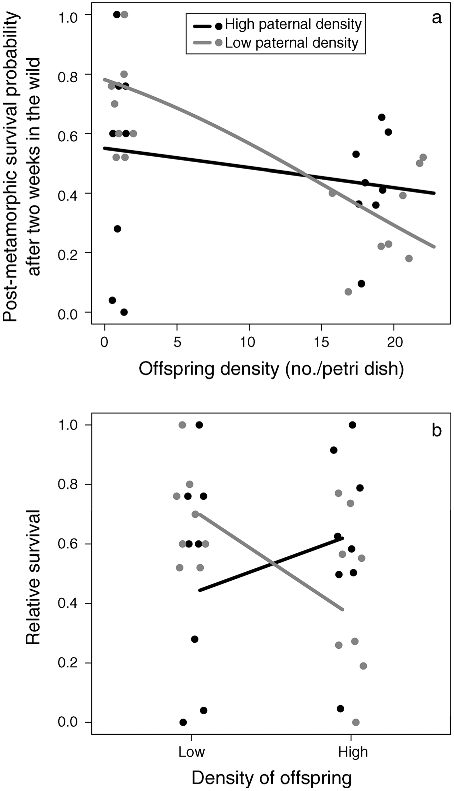to the mortality risk of grandsons (Pembrey et al. 2006).
In mice, paternal obesity reduces sperm function (Bakos
et al. 2011), impairs embryo development and viability
(Mitchell et al. 2011), and diminishes the reproductive
health of offspring for two generations (Fullston et al.
2012). To date, studies of nongenetic paternal effects
have focused on the transgenerational effects of paternal
behavior, nutrition, toxins, and age (Curley et al. 2011).
Thus, with the exception of cases of paternal care, it is
unclear whether nongeneti c paternal effects can be
adaptive, whether they are vehicles for the transfer of
pathological effects, or whether they are simply physi-
ological inevitabilities (Marshall and Uller 2007).
Concurrently, evidence is accumulating that males can
adjust their sperm phenotype in response to their social
environment and perceived risk of sperm competition
(e.g., Cornwallis and Birkhead 2007, Simmons et al.
2007, Crean and Marshall 2008, Immler et al. 2010). The
functional consequences of this plasticity in sperm
phenotype have only been considered in terms of their
effects on fertilization success (Pizzari and Parker 2009),
and thus this potentially important source of paternal
effects remains unexplored. The recent evidence that
sperm can transfer more than just the paternal genome
raises the possibility that plasticity in sperm phenotype
may have transgenerational consequences for offspring
performance, and thus population dynamics (Zeh and
Zeh 2008). In biomedical studies of humans, there has
been increasing speculation regarding the existence of
‘‘adaptive’’ paternal effects (e.g., the ‘‘thrifty telomere
hypothesis’’; Eisenberg 2011), whereby males adjust the
phenotype of their sperm in response to their own
environment in order to increase offspring fitness. While
the potential for such effects is clearly exciting, it has not
been explored empirically.
External fertilizers are an ideal system in which to
empirically examine paternal effects, as eggs are released
before fertilization, precluding the possibility of females
biasing their investment in response to sperm quantity
or quality (Cunningham and Russell 2000, Sheldon
2000). In addition, sessile organisms cannot move after
settlement to cope with environmental heterogeneity,
and therefore developmental and tra nsgener ational
plasticity may be particularly important mechanisms to
ensure offspring success in these species (Galloway and
Etterson 2007, Uller 2008). However, unlike plants, as
both gametes are released prior to fertili zation in
broadcast spawners, paternal effects may be equally as
likely as maternal effects to develop in these systems.
Variation in conspecific density is an i mportant
ecological driver in marine sessile communities,
directly influenc ing the availability of food and space,
with strong effects on post-settlement survival and
growth (Allen et al. 2008). We have previously
demonstrated that the broadcast-spawning ascidian
Styela plicata adjusts the phenotype of their sperm
(size, motility, and longevity) in response to changes
in the density of co nspecifics (Crean and Marshall
2008). Furthermore, significant spatial genetic struc-
ture has been detected am ong S. plic ata individuals at
the same loca ti o n as the pres en t st ud y tha t wer e
0–5 m apart (David et al. 2010), suggesting that
dispersal distances are short an d thus the paternal
environment is likely to be a good predictor of the
offspring environment: a requirement for adaptive
transge ne ra ti on a l plastic it y (Gallow ay and Etterson
2007). Here , we manipulate the paternal environment
using the same field manipulation previously shown to
induce plasticity in sper m phenotype (Crean and
Marshall 2008). We use sperm collected from males
in these high- and low-density treatments to in vitro
fertilize a common pool of eggs, and track the
performance of offspring. Offspring developmental
performance is mea sured in the laboratory (due to
logistical constraints), and post-metamorphic perfor-
mance is measured in the field in both low- and high-
densit y co nditio ns t o te st for adap tive paternal
effects.
M
ATERIALS AND METHODS
Study species and field location
We used the solitary ascidian, Styela plicata, as a
mod el system to examine envir onmentally induced
paternal effects, as previous work has shown that they
exhibit plasticity in sperm size, motility, longevity, and
fertilization potential (Crean and Marshal l 2008).
S. plicata is a hermaphroditic broadcast spawner
commonly found in disturbed habitats such as marinas
and harbors throughout eastern Australia (Kott 1972).
We completed all field work at the East Coast Marina
(Manly, Brisbane, Australia; 27.4678 E, 153.1838 S), a
sheltered private-access marina consisting of floating
pontoons. At this site, S. plicata naturally occur in
densities ranging from isolated individuals to large
clumps (e.g., .50 adults on 1 m length of rope; A. J.
Crean, personal observation). Reproductively mature
individuals are present at this site most of the year,
excluding winter months (July to September; A. J.
Crean, personal observation).
Manipulation of the paternal habitat
The paternal envi ronment was manipulated using the
same density manipulation methods that were shown
previou sly to indu ce adapt ive plas tic ity in sper m
phenotype (Crean and M arshall 2008). Briefly, repro-
ductive adults were collected from the field site and
randomly allocated to either a high-density (15
individuals) or a low-density (single individual) treat-
ment cage (cage dimensions, 18 3 18 3 18 cm; mesh
size, 1 cm
2
). Treatment cages were suspended from the
pontoons and maintained in the field for one month,
and th en a randomly selected h igh-density in dividual
from each cage and all low-density individuals were
transported to the laboratory at the University of
Queensl and. Im portantly, no mortality of tr eatment
ani mals occurred in any of the high- or low-density
ANGELA J. CREAN ET AL.2576 Ecology, Vol. 94, No. 11











